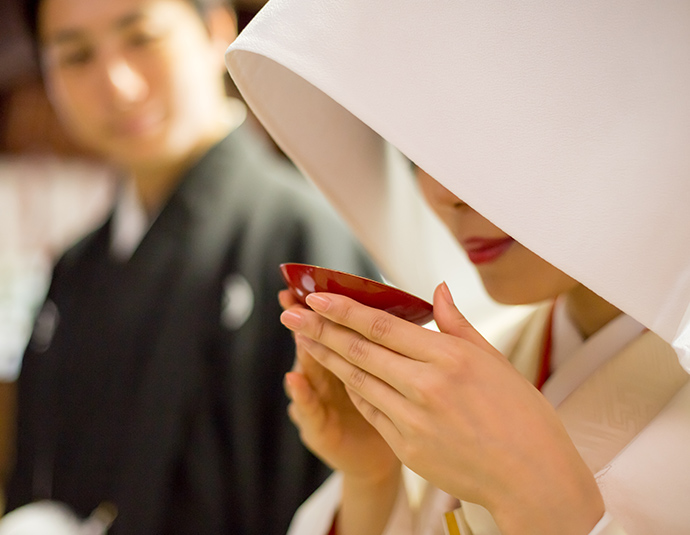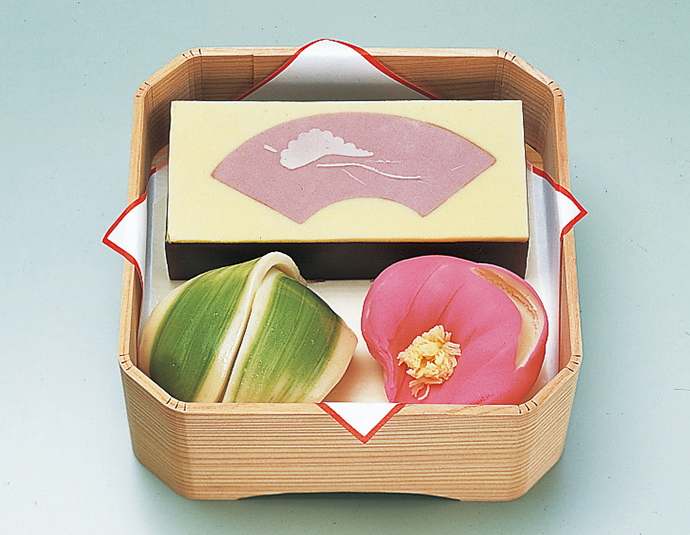
Lifestyle culture and Wagashi
EXPLORE Explore the tradition of Wagashi

In Japan, there are many events that mark people’s lifetime. Examples include birth, first shrine visit, first seasonal festival, one year old birthday, shichi-go-san, Coming-of -age day, wedding ceremony, celebration of longevity, funeral ceremony, and the anniversary of one’s death, etc. Wagashi has traditionally been an integral part of these events. At times of both joy and sorrow, Wagashi takes an indispensable supporting role in the event and has been nurturing presence in people’s lives.
Now, we shall introduce some of the relations between Japanese events and Wagashi.
First Shrine Visit


The first visit for the new born baby to a shrine (dedicating to the tutelary deity) refers to “Shrine Visit” or “First Shrine Visit”. They take their baby to the deity, and pray for the baby’s healthy growth and the deity’s protection. On the day of the shrine visit, parents invite their relatives and friends to make the celebration, and send them the return for their birthday gift. “Kohaku manju-red and white stuffed bun”, “Tsurunoko mochi-red and white egg-shaped mochi”, and “Omedeto (‘to’ means sugar)” are usually used for the return goods.
Okuizome-Weaning ceremony


Okuizome is a ceremony wishing for the infant to have no trouble eating and to have a smooth transition to solid foods. A celebratory meal is prepared consisting of one soup and three dishes. This is conducted by his family in order to strengthen the weak infant by sharing the table with everyone. “Kohaku manju-red and white stuffed bun”,” Osekihan-red rice” are used for Okuizome celebration.
Doll’s Festival


This is the event of praying for girls’ healthy growth. By decorating dolls, people wish their girl’s misfortunes would be assumed by the dolls. At the doll’s festival, “Hishimochi, diamond-shaped mochi”, “Hinaarare, tiny ball-shaped rice crackers”, and “Sakura mochi, dumpling with a cherry leaf” are served. Hishimochi comes from the legend that mountain hermits lived long by eating water chestnuts, and so it was also called “rice cake praying for longevity”.
Tango no sekku - children’s day


Tango no sekku is the event that celebrates boys’ healthy growth. By decorating a Kabuto-armor helmet, people make a wish that their children can be protected from disease and accidents, and grow up healthy. People wish that their children can grow up cheerfully as carp-shaped streamers hang outside swimming in the wind. Kashiwa mochi, used for the thank you gifts, has a good omen that the old leaves of Kashiwa never fall down until new leaves grow, so that people put their wishes for the prosperity of descendants on Kashiwa leaves.
Shichi-Go-San


It is a celebration for boys of 3 and 5 years old and girls of 3 and 7 years old which is observed by visiting shrines to give thanks for the growth of children on November 15th. For this celebration, “Chitose-ame, a long stick of red and white candy”, “Torinoko-mochi, red and white oval-shaped rice cake”, “Tsurunoko-mochi, red and white egg-shaped rice cake”, “Hiki-gashi, ornamental cake’’, and “Sekihan, red rice” are served.
Celebration of entering and graduating
from kindergarten or school


Each time children enter or graduate from school, their family celebrates the day by giving thanks for healthy growth and hoping for their future growth. Further, this is the day of thanking the people, other than the family, who helped and supported the children. To the people who sent gifts for the children, “Kohaku Manju, red and white stuffed bun”, “Sekihan”, or “Tsurunoko-mochi,” are sent as thanks.
Engagement, wedding celebration


Engagement is a ritual making a proposal for marriage, and one of the the happiest events in our lifetime. The custom of bringing betrothal goods with celebratory Wagashi has long been observed, when visiting the house of the partner to be and exchanging the engagement goods. At the wedding ceremony, they serve celebratory dishes and prepare for“Hikigashi, ornamental cake”, which expresses monumental remembrance to the couple.